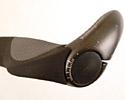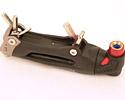Ergon grips - mmm, comfy
Ergon grips look different
from other grips
Photo ©: James Huang

|
Invariably, the response to these rather odd-looking grips from
first-time viewers was the same on just about every occasion:
"[with puzzled look on face] What on earth are those things?"
After the requisite place-their-hands-on-the-grips test, though,
the conversation immediately changed to:
"[with now surprised look on face] Those feel awesome; where
can I get a set?!"
The ergonomic grip idea is hardly new: some may remember Sampson's
version from about a decade or so ago (and we're sure there have
been many others), but Germany-based Ergon seems to have finally
nailed down the formula. Each Ergon grip (barring the GE1 model)
features a prominent 'wing' that distributes load over a much broader
portion of the palm than with typical round-section grips, thus
reducing pressure on critical areas.
According to Ergon, conventional grips contact only about 60% of
the surface area of a rider's palm. In contrast, its ergonomic grips
supposedly can attain as high as 100% surface contact, and to help
this along, most of the line is offered in two sizes to fit smaller
or larger hands. Some models also incorporate independently adjustable
integrated bar ends in either aluminum, magnesium, and even carbon
fiber, and all offer secure clamp-on attachments.
Bar ends are smoothly contoured
Photo ©: James Huang

|
The grip's unique shape definitely takes a little getting used
to on the bike. Once you get over the novelty, though, the overwhelming
sensation is that you're no longer paying attention to your hands
at all. Long-term comfort is outstanding with little to no numbness
or hot spots in the palm or fingers. Ergon doesn't even mention
it, but we also found it to help with blisters, too.
The downside of all of this added comfort, however, is simply more
grip than some will tolerate, and we're not talking about tire adhesion
here. The additional material deadens some of the feedback and response
that thin grip devotees love, and all that rubber invariably costs
at the scale, too. A pair of small diameter GP1 grips weighs 208g
while a set of GR2s with integrated magnesium bar ends is a rather
portly 268g. In addition, the wing also somewhat limits positioning
flexibility while on the bike, especially in more demanding situations.
Ergon addresses those issues with its latest "competition-oriented"
GX1 model with a lighter 128g/pair weight (thanks to liberal use
of lighter Kraton rubber) and a pared-down wing. Alternatively,
its more conventional GE1 grip offers even more flexibility but
does without the wing section entirely.
Either way, riders that experience any sort of hand discomfort
should take a serious look at these things (after first making sure
their bike fits properly!). Be prepared to deal with some odd looks
and the occasional jeers, but just consider yourself ahead of the
curve.
Weight: 128g/pair (GX1); 208g/pair (GP1); 268g (GR2 with
magnesium bar ends)
Price: US$39.99 (GX1); US$29.99 (GP1 and GR2)
Pros: Absolutely superb long-term comfort, virtually eliminates
hand numbness and hot spots
Cons: Somewhat heavy compared to conventional grips, limited
positioning flexibility while on the bike
Cyclingnews rating: 
PhotographyFor a thumbnail gallery of these images, click here
Images by
James Huang/Cyclingnews.com

Blackburn AirFix and AirShot - works in progress
Blackburn enters the CO2
inflator market
Photo ©: James Huang

|
Much like the situation in the hydration pack market, Blackburn
faces an uphill battle with its CO2 inflators. As the undeniable
underdog against well-established Genuine Innovations, Blackburn
has to offer more, work harder, and work smarter in order to get
a piece of the market pie and tries to do just that with its AirFix
and AirShot models.
Both inflators are heavily stylized items with an industrial futuristic
look in keeping with the rest of Blackburn's current lineup. The
AirFix definitely goes with the 'offer more' route; its substantial-feeling
injection molded plastic and metal body incorporates an impressive
laundry list of tools, including 3, 4, 5, 6, and 8mm hex keys, a
T25 Torx bit, chain tool, flat head screwdriver, and even a steel-cored
tire lever.
In contrast, the more minimalist AirShot offers just a supplemental
tire lever and single 5mm hex bit. Both inflators utilize Blackburn's
excellent inflator head with a built-in pressure regulator for more
controlled flow, presta/ Schrader-compatible valve, and a safety
switch to prevent misfires. Both are also exclusively designed around
the versatile (and relatively economical) 16g CO2 cartridge.
Outstanding head incorporates
a pressure release lock
Photo ©: James Huang

|
The inflator head is easily the highlight of both the AirFix and
the AirShot, with intuitive operation and a quality look and feel
thanks to the red-anodized aluminum and brass construction. Blackburn's
inflators also offer a sense of solidity in the hand with their
slightly larger diameter and squared-off shapes.
That solid feel also translates into a lot of bulk, though. While
the AirShot body is noticeably bigger than its competition, we're
somewhat willing to forgive that added volume for the excellent
head and handy built-in tire lever. The AirFix, on the other hand,
is not only markedly bigger, it's also surprisingly weighty at 190g,
and that's not even including the requisite cartridge which tacks
on yet another 50g or so.
Moreover, some of the tools on the AirFix are awkwardly positioned,
making it difficult to access some bolts, or even completely impossible
in some cases as we discovered on more than one occasion. The 4mm
hex wrench, in particular, is almost laughable. Its matching 4mm
bit length (yes, we said four) and inconvenient location on the
end of the tire lever made it virtually unusable; we couldn't even
loosen faceplate bolts on some stems when we tried to do a quick
handlebar rotation on the road, and you can forget about making
saddle adjustments on most two-bolt seatposts.
The AirFix includes a lot
of tools
Photo ©: James Huang

|
Lastly, while we're with Blackburn on its 16g cartridge format,
the AirShot and AirFix will only accept 16g non-threaded cartridges
which are often somewhat difficult to find. The more common non-threaded
12g cartridges can be made to work in a pinch, but you won't be
screwing the otherwise superb head on to your 25g Big Air canister
any time soon.
Blackburn's CO2 inflators definitely show a lot of promise but
could stand a little refinement and a whopping dose of compatibility.
Both are also rather expensive as compared to their more capable
competitors. Cost issues notwithstanding, the AirShot would be a
contender if it was modified to accept a wider range of cartridges,
but we'd have to recommend passing on the AirFix entirely. While
it's reassuring to know that you have tools on hand when the need
arises, it's simply maddening when the one you need isn't even usable.
Weight: 78g (AirShot, without cartridge); 190g (AirFix,
without cartridge)
Price: US$29.99 (AirShot, with one 16g cartridge); US$39.99
(AirFix, with one 16g cartridge)
Pros: Outstanding inflator head design, squared-off bodies
provide substantial grip
Cons: AirFix tools are difficult to use in real world conditions,
extremely limiting cartridge compatibility, expensive
Cyclingnews rating:  (AirShot);
(AirShot);  (AirFix)
(AirFix)
PhotographyFor a thumbnail gallery of these images, click here
Images by
James Huang/Cyclingnews.com

|







